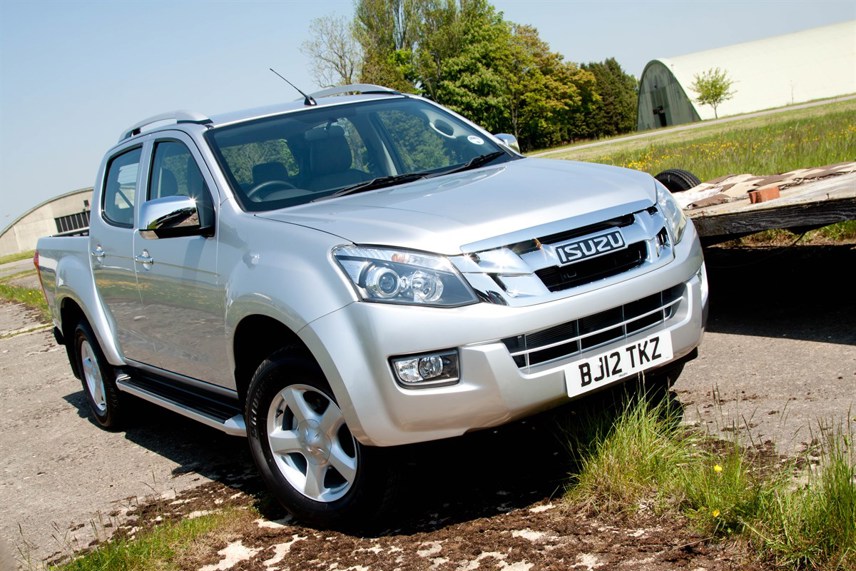Review
The Isuzu Rodeo was always one of the minor players in the UK 4x4 truck sector. But with the launch of its replacement the D-Max -– things could be about to change big time.
At the launch in Gloucestershire, Paul Tunniclife, managing director of importer IM Group, confidently predicted that the D-Max would one day lead the sector, although he didn’t put a date on it.
The D-Max is available in three guises – single-cab, extended-cab and double-cab – and there will be four trim levels – base, Eiger, Yukon and Utah. Unlike most other contenders in the sector – and probably important for fleet buyers – the “cooking” version will be available in double-cab format.
The cabin is 21cm longer than the old Rodeo and there is more legroom under the dash. There is 25mm more legroom for rear seat passengers in the double-cab and the rear seats are reclined at a greater angle for extra comfort.
Noise insulation has been improved upon with extra engine bay padding and different body mountings, while the sleeker design improves on aero-dynamics for greater fuel economy.
Entry-level models have steel wheels, air-con, electric windows and front, side and curtain airbags while the Eiger adds alloy wheels, body-coloured bumpers, remote central locking, heated folding mirrors and chrome door handles.
The Yukon – expected to be the biggest seller – comes with added six-speaker audio package, leather steering wheel, cruise control, chrome grille and rear bumper, side steps and rear load liner while the Utah also has heated front seats, climate control, roof bars and parking sensors. A new twin-turbo 2.5-litre engine powers the D-Max, offering 163bhp and a meaty 295lb-ft of torque from a low 1,400rpm, while returning 38.2mpg on the combined cycle.
The D-Max will tow up to 3,000kg braked and can be changed from two to four-wheel drive at speeds up to 60mph.
Power is transferred via either a six-speed manual gearbox or five-speed auto and, as announced at the launch, the D-Max comes with a class-leading five-year 120,000 mile warranty. Prices range from £14,499 to £21,499 ex-VAT.
Verdict
In an age when 4x4 trucks are getting ever better looking and more powerful, the D-Max stands out as a stunner. Mind you with the new VW Amarok and Ford Ranger snapping at its heels – and with a much smaller dealer network than those two titans – the Isuzu sales team are going to have their work cut out to make the firm’s sector leading dreams come true
Behind the wheel
The new D-Max is one of those vehicles that manages to look both stylish and tough at the same time.
It’s a big truck and although only double-cab versions were available at the launch, I was glad to see that there were some lower spec versions on offer too.
We tested the D-Max both on- and off-road and our first drive, along twisty country lanes and some fast A roads, was in the Eiger, which is one up from the base spec.
Even so, the interior didn’t disappoint. The seats are huge and comfortable, there are three coffee cup holders just in the right places and six grab handles.
Mind you, this variant featured one of those fiddly little stereo units full of flashy lights and tiny buttons that you can’t get your fingers into properly.
The engine fires up with a meaty thrum and underway, feels lively in the extreme, although curiously the D-Max’s gearlever is about a foot long and led to some rather rubbery changes.
The steering wheel is huge but the power steering is nice and light. Some of the roads we travelled on were pretty bumpy, but this didn’t seem to affect comfort as, even empty, the D-Max wasn’t skittish and seemed to glide over the ripples.
Changing from two- to four-wheel drive is a simple matter of rotating a switch in the console.
At a specially designed off-road course, the D-Max showed its macho side. I don’t pretend to be a mud-plugging expert, but with a trainer beside me I managed to get through one of the toughest off-road courses I’ve ever experienced.
The Isuzu team was keen to show off just what this vehicle will do and it left me hugely impressed, despite the fact that this vehicle doesn’t have hi-tech features like hill-hold, an extra that some of the opposition offer.
We traversed near vertical slopes, deep rivers and scary inclines but not once did the D-Max look like faltering.On the return journey we swapped into a range-topping Utah auto, with leather seats and upgraded stereo system and with the gearlever (a smaller on this time) in drive, we glided off complete with a tonne of sand in the back.
While both driver and passenger could feel the extra weight, the D-Max still felt lively on the road and cornering was as neat and accurate as with the empty truck.
















